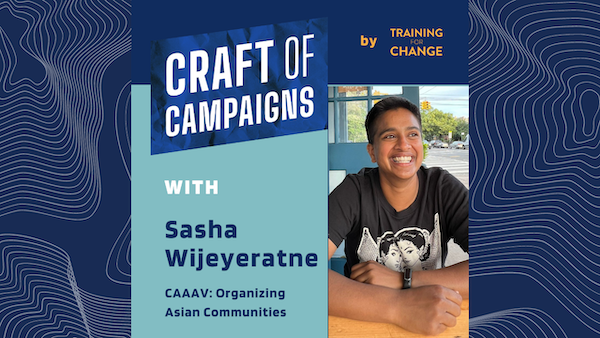The Craft of Campaigns podcast highlights stories and lessons from issue-based action campaigns beyond one-off mobilizations and single election cycles. Campaigns channel grassroots energy to win concrete victories, build winning coalitions, and topple pillars of power standing in the way of justice. In each episode, we interview organizers about how a campaign unfolded, the strategy decisions they made, and the lessons we can draw for our current moment. You can read the writeup below or check out the full podcast here.
When the world’s largest company announces it has set its sights on your working-class neighborhood for its new headquarters, what are the odds you can stop them?
That was the question facing a coalition led by community organizations — with some union support — when Amazon announced that the Empire State had “won” its bid to host the company’s new headquarters. Already, dozens of elected officials had signed on to the state’s HQ2 bid, as it was known, and several prominent labor unions supported it too. Most significantly, the bid was being pushed by Governor Andrew Cuomo, who at the time was the most powerful figure inside the state Democratic Party.
Local organizers were incensed by the deal to provide Amazon with billions of dollars in tax breaks and worried about the potential impact on the local housing market. They knew they had to organize quickly to oppose the deal. The “No to Amazon” coalition used an inside/outside strategy, with organizations playing to their strengths in pressuring elected officials, organizing public housing residents in Queens, and holding dramatic protests outside City Hall. The combination of tactics made the deal too costly to continue.
Although the sudden victory made national news, not much has been written about the four-month campaign that preceded it, much less the choice points organizers made along the way. We talked with several organizers from the coalition – Sasha Wijeyeratne, Fahd Ahmed, Sol Freire Figueroa and Garret O’Connor – about their strategic considerations and key lessons from the campaign, which ended when Amazon announced in February 2019 that it would not move forward with a new headquarters in Queens. .
Holding the line on the demand
The coalition advocated for a hard-line, no-deal-under-any-circumstances approach. Sasha Wijeyeratne, who started their current position as executive director of CAAAV: Organizing Asian Communities just a few weeks before Amazon’s announcement, remembers: “Our members live in Queensbridge Houses, the largest public housing community in the country. Looking at what happened in Seattle, we knew there was no way they would still be around to benefit from any possible economic development. They were going to be pushed out.” Other members of the “hard no” coalition included Desis Rising Up & Moving (DRUM), New York Communities for Change, Make the Road NY, ALIGN, Jews for Racial and Economic Justice, and the Retail & Department Store Workers Union.
RDSWU was an outlier. Several other large unions — including those in construction and janitorial services — had backed HQ2, trusting the company’s promise to provide union contracts. RWDSU, however, had been organizing workers at the Amazon warehouses on Staten Island and was skeptical. The union joined the coalition against the headquarters. O’Connor recounts: “HQ2 was an example of community groups taking a position, setting the agenda, and wielding real leverage, and they determined the goal, not the people funding the table or people sitting at the central table. The decision of ‘No HQ2’ rather than ‘No HQ2 Unless…’ really came from the community groups. That was a learning experience for me and the union. If you’re going to get into deep and genuine collaboration, they have to be real equals at the table.”
Identifying the right leverage and tactics
The coalition set to work to figure out where they could generate the leverage to stop HQ2. They considered but quickly ruled out a boycott against Amazon. As Fahd Ahmed from DRUM explained, “We did some quick research and learned that Amazon doesn’t even make money off its marketplace, and they actually lose money there. It’s the digital stuff and AWS [Amazon Web Services] where they make a lot more money. Even if the boycott were a point of vulnerability for Amazon, I don’t think we could have pulled it off. People are so accustomed to the convenience that it would be hard.”
They used a classic organizers’ power map to identify where they did have leverage, looking at decision-makers across the state who could stop the deal. Ultimately, they decided on an inside/outside strategy. Within the halls of power, they would target officials representing Queens in order to pressure the state’s Economic Development Council and the Public Authorities Control Board, the state bodies responsible for distributing the tax subsidies. Wijeyeratne says they looked at “who were the different players at the city, state, within Amazon, about who would be the ones that could say they could go forward, who could vote yes or no at different stages on different pieces.”
Right away, the groups realized they would have to peel elected officials away from the pro-Amazon, Cuomo-led bloc. And to do that, they would need to demonstrate broad opposition in Queens. “We were thinking about how to affect their image and support they had from politicians,” recalls Sol Freire Figueroa, New York Communities for Change then Digital Director,. “That’s where direct actions and calling them out on social media came into play. We started gathering and airing all their dirty laundry: how bad for business they are, how terrible they’ve been for Seattle where their first HQ is, the terrible gentrification; how that would impact New York, which already has a terrible housing crisis.”
Fahd adds, “any and every opportunity to talk about HQ2 — City Council hearings, economic development events, and fancy events from realtors — we went and protested outside of those. We got into some of them and disrupted them from the inside. Anywhere and everywhere we could get an opportunity, we would jump on it. We put most of our other programming on hold.”
The organizers worked with artists experienced with protest visuals at Look Loud to “brand hack” Amazon’s logo — turning the delivery smile into an angry face and creating an immediately recognizable visual opposition that media outlets could feature in their stories. “Communicating that message nonverbally was pretty critical to influencing opinion,” O’Connor recalled. “There’s stuff that a spokesperson can say that’s quotable, but when you have a picture and headline that tells the story, that goes a very long way.”
Building Queens-based opposition through door-knocking and public education
As Amazon blanketed the city, and particularly Queens, with billboards, mailers, and digital ads touting the promise of economic opportunity, the coalition had to educate thousands of sympathetic working-class residents on the threat the company posed — and galvanize them to take action.
Wijeyeratne recalls: “We knocked over one thousand doors in one day in the Queensbridge Houses and struggled with people around whether this was a good idea. Over 75% by the end of the conversation said, ‘Okay, they shouldn’t come here.'”
Being able to show some level of active opposition in the neighborhood also undermined Amazon’s claims to legitimacy, according to Wijeyeratne. “They had an advisory council, which included a large number of the tenant associations directly next door. So, peeling away the veneer of community support, being able to show, sure, a singular person representing the tenant association supports but their members do not agree with their singular stance.” When Amazon argued that it had a community board in favor of the deal, organizers could hold up thousands of pledge cards opposing HQ2 that they had gathered by canvassing in Queens.
Three Months In, Signs We’re Winning
After several months of protests and door-to-door outreach, the coalition began to see the political landscape shift in their direction. As Wijeyeratne recounts, “There was a lot of fear at that time from elected officials about being primaried from the left — AOC’s victory was still hanging in the air — and so elected officials were willing to flip to be on our side. And to give credit where it’s due, a number of organizations with political relationships were using their connections to make that happen, and then electeds also started putting pressure on each other.”
Wijeyeratne credits the willingness of many electeds to flip to the coalition’s ability to create a “polarizing fight….We tried to make it toxic to support them… It was either you support communities and you kick Amazon out, or you support Amazon and betray the rest of us.”
The governor had offered Amazon $3 billion in incentives for HQ2, but a state agency, the Public Authorities Control Board, was rumored at the time to have the power to veto up to $500 million of that state subsidy (the campaign ended before Cuomo and his opponents’ dueling theories on the board’s jurisdiction could be confirmed). On February 3, the State Senate appointed onetime-Amazon-friend-turned-chief-opponent, Sen. Michael Gianaris, to the three-member PACB board. “We got lucky that Genaris was so high up and was based in Western Queens,”Wijeyeratne argued. “We try not to overemphasize electeds; we understand organized people is one of the core tenets of building power, but a lot of the concluding moments of the campaign involved getting elected officials to stand against Amazon.” .
On Valentine’s Day 2017, Amazon announced it was canceling its Queens “HQ2” and doubling down on another planned East Coast headquarters in Northern Virginia. “It was incredible. We had a dance party in Queens that night to celebrate. It was freezing,” laughed Wijeyeratne. “But it was also in some ways too soon. We had thought we would be in that fight for years, and we hadn’t prepared for what could come next.”
Reflections & Lessons Learned: “Holding a ‘Hard No’” & “Coalition Isn’t Home”
Wijeyeratne wishes the coalition had been able to channel the momentum they had built against “a shared villain, a shared demand, a hard no” into proactive fights to make their organizing visions reality — rather than simply fend off a corporate threat. “It’s much easier to say ‘no’ and kick out the things that you don’t want in your neighborhood than it is to actually transform the way cities or states work. It’s much harder to align ourselves around a vision and implement it. Now we’re in this massive fight against another development project, Innovation Queens, to stop their rezoning from taking over our neighborhood. That fight has been so hard, pushing our own actual vision. Even the base building around that is so much harder than a fight that’s clear and concise.”
But she credits the “No HQ2” campaign with helping CAAAV stick to its principles in more recent policy battles. “It’s made us more willing to hold a ‘hard no’ when the common logic is you let something happen and get as many benefits as you can. It’s not just an ideological or a moral position; it can be a winnable one based on your conditions and the power map.”
Wijeyeratne says the experience — although it was “the best I’ve had working in coalition” — also gave them a greater appreciation for an insight from Bernice Johnson Reagon that coalition isn’t home. “We built a lot of trust and alignment. We struggled when we needed to, but we had different roles. People who could move the electeds moved the electeds, people who could build a base that was local that had both moral and political power, we built that; the people really good at media, at narrative, at developing beautiful images, they did that. And at the end of the campaign, the coalition ended and that was the right move. We weren’t in a unifying fight anymore, and just because we fought well together doesn’t mean we keep doing it.”


